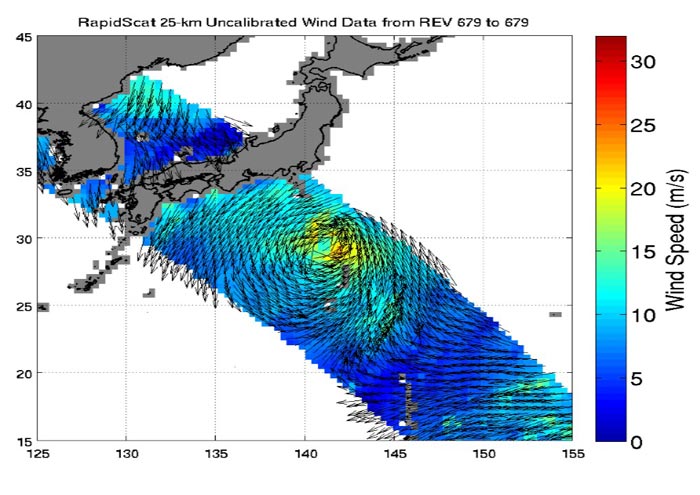NASA Eyes Post-Tropical Storm Nuri's Winds, Now to Affect Alaska

On Nov. 6, Rapidscat showed Nuri's sustained wind speeds around the center of circulation were near 20 meters per second/72 km/44.7 mph (yellow). Image Credit: NASA JPL
“RapidScat passed over Nuri, near Japan, three times within a 24 hour period,” said Doug Tyler of NASA's Jet Propulsion Laboratory, Pasadena, California. “The progression [in three images] showed Nuri’s path.”
RapidScat measured Nuri's wind speeds twice on Nov. 5 and saw strongest winds, as fast as 30 meters per second (108 kph/67.1 mph), appeared in the northwestern and southeastern quadrants. On Nov. 6, RapidScat showed sustained wind speeds around the center of circulation had decreased to near 20 meters per second (72 kph/44.7 mph).
The International Space Station-Rapid Scatterometer, or ISS-RapidScat was launched Sept. 21, 2014 to the International Space Station. From the unique vantage point of the space station, this space-based scatterometer instrument will use radar pulses reflected from the ocean's surface from different angles to calculate ocean surface wind speeds and directions.
On Friday, Nov. 7, NOAA's National Weather Service (NWS) Office in Anchorage, Alaska issued a High Wind Warning for the Western Aleutian Islands including the cities of Shemya and Amchitka. The warning was posted at 4:23 a.m. AKST on Nov 7 and remains in effect through 9 a.m. AKST on Saturday, Nov. 8.
The warning states that southwest winds 20 to 35 mph (32.1 to 56.3 kph) early on Nov. 7 will rapidly increase to south 60 to 75 mph (96.5 to 120.7 kph) with gusts of 80 to 90 mph (128.7 to 144.8 kph) by late morning. During the afternoon and evening winds will shift to the southwest and continue through Saturday morning before slowly diminishing. Any travel may be difficult. Loose debris can be moved and damage property.
Marine interests have a hurricane force wind warning through tonight, Nov. 7, as during the day, sustained winds will increase from 30 knots (34.5 mph/55.5 kph) to 70 knots (80.5 mph/129.6 kph). On the Bering side seas will be as high as 20 feet building to 28 feet in the afternoon. On the Pacific side of the islands, seas will be 24 feet (7.3 meters) building to 35 feet (10.6 meters) in the afternoon with rain. At night on Nov. 7, southwesterly winds will increase to 70 knots (80.5 mph/129.6 kph) and seas are expected to reach 45 feet (13.7 meters) in rain showers. By Saturday, Nov. 8, sustained southwesterly winds are forecast near 55 knots (63.9 mph/101.9 kph) with 39-foot (11.8 meter)-high seas on the Bering Sea side and 41-foot (12.5 meter) high seas on the Pacific side.
The marine forecast calls for strong winds to continue through Tuesday. On Sunday, Nov. 9, sustained winds are expected near 50 knots (57.5 mph/92.6 kph), Nov. 10, sustained winds forecast near 40 knots (46.0 mph/74.0 kph), and 30 knots (34.5 mph/55.5 kph) by Nov. 11. For updated forecasts, visit:
http://pafc.arh.noaa.gov/ and http://forecast.weather.gov/MapClick.php?lat=51.96416557300046&lon=177.45999896600063&site=all&smap=1#.VFztmxCq6RJ
ISS-RapidScat is a partnership between JPL and the International Space Station Program Office at JSC, with support from the Earth Science Division of NASA's Science Mission Directorate, Washington. Other mission partners include the Kennedy Space Center, Florida; NASA's Marshall Space Flight Center, Huntsville, Alabama; the European Space Agency; and SpaceX.
For more information on ISS-RapidScat, visit: http://winds.jpl.nasa.gov/missions/RapidScat/ or http://www.nasa.gov/rapidscat
Rob Gutro
NASA's Goddard Space Flight Center
Media Contact
All latest news from the category: Earth Sciences
Earth Sciences (also referred to as Geosciences), which deals with basic issues surrounding our planet, plays a vital role in the area of energy and raw materials supply.
Earth Sciences comprises subjects such as geology, geography, geological informatics, paleontology, mineralogy, petrography, crystallography, geophysics, geodesy, glaciology, cartography, photogrammetry, meteorology and seismology, early-warning systems, earthquake research and polar research.
Newest articles

Superradiant atoms could push the boundaries of how precisely time can be measured
Superradiant atoms can help us measure time more precisely than ever. In a new study, researchers from the University of Copenhagen present a new method for measuring the time interval,…

Ion thermoelectric conversion devices for near room temperature
The electrode sheet of the thermoelectric device consists of ionic hydrogel, which is sandwiched between the electrodes to form, and the Prussian blue on the electrode undergoes a redox reaction…

Zap Energy achieves 37-million-degree temperatures in a compact device
New publication reports record electron temperatures for a small-scale, sheared-flow-stabilized Z-pinch fusion device. In the nine decades since humans first produced fusion reactions, only a few fusion technologies have demonstrated…





















